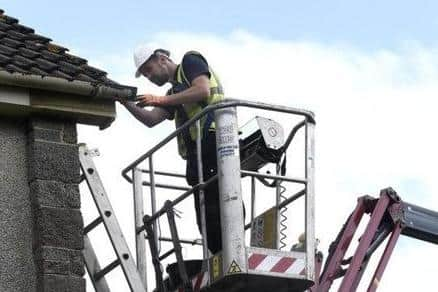West Lothian: RAAC found in 69 council homes
and live on Freeview channel 276
Surveys have also confirmed its discovery in 15 blocks of flats.
The crumbling concrete, first found in 2002 in the Deans South homes built by Livingston Development Corporation has now been found in council houses and common blocks in Broxburn, Bathgate,Linlithgow and a small a number in Craigshill.
Advertisement
Hide AdAdvertisement
Hide AdThe council has advised all residents affected. They will have to be temporarily rehoused while remedial work is carried out


Reinforced Autoclaved Aerated Concrete (RAAC) is a type of construction material that was commonly used in social housing in West Lothian between the 1950s and 1980s. RAAC has been associated with various issues, including structural defects.
West Lothian Council has already spent £52m trying to tackle RAAC found in schools, community halls and other public buildings.
It was one of the first councils to address the issue following the discovery in public buildings.
Advertisement
Hide AdAdvertisement
Hide AdHowever the council has long faced criticism from former home-owners including Kerry Mackintosh who campaigned for almost 20 years for compensation having bought a former LDC home inDeans South.
While the bulk of the Deans South estate was cleared of tenants when the RAAC was discovered, nine families who had bought their homes were left with a lengthy battle for meaningfulcompensation.
That was only achieved last year when a deal for a home for a home was achieved after negotiations with Springfield Homes.
Kerry is now advising tenants in Livingston flats who fear the material was used in their homes.
Advertisement
Hide AdAdvertisement
Hide AdA report to the Housing Services Policy Development and Scrutiny Panel which meets next Friday confirms that there are 14,243 council homes in West Lothian, and that RAAC is present in 69 homes (less than 0.5 per cent of the council housing stock). Surveys have also confirmed the presence of RAAC in 15 common blocks.
Intrusive surveys will need to take place and independent consultants have provided an indicative estimate cost of £4.3million to carry out removal and reinstatement works across all properties.
The council said intrusive surveys, and follow on work, will be carried out in a planned and structured way. Initially, properties will be prioritised for repairs and the intrusive surveys will providedetailed information on the condition of RAAC panels. Survey data will then be analysed to inform what work is necessary.
It was confirmed that as part of the removal works ‘it will be necessary for tenants to be temporarily moved to a property close to where they are currently located’ for a short period of time in order tofacilitate the works.
Advertisement
Hide AdAdvertisement
Hide AdThis will also be undertaken on a planned basis over the course of the project and tenants will be fully supported during this process. Tenants affected by RAAC in common blocks are less likely to berequired to move homes on a temporary basis.
It is understood private homes may also be affected, as the estates identified are a mix of council and privately owned homes.
Private home-owners are responsible for any maintenance or repair work. The council will now write to the affected private owners and advise them of the issues found in council properties of thesame type and recommend they instruct their own structural survey.
Julie Whitelaw, Head of Housing, Customer and Building Services said: “There are a very small percentage of council homes affected overall and the tenants affected have been informed.
Advertisement
Hide AdAdvertisement
Hide Ad“Obviously for the 69 council homes affected the work to carry out intrusive surveys and any subsequent repairs could be significant, which is why we are adopting a planned approach to the surveywork. We can assure our tenants that we will support them and ensure that they are provided with information and assistance throughout.”